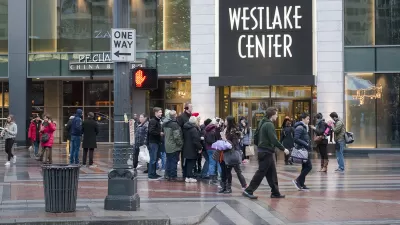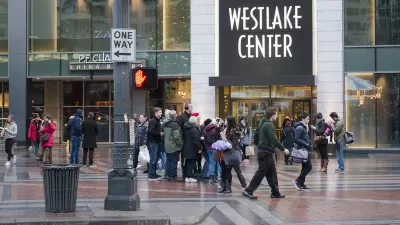With the plan update process for Seattle's Pedestrian Master Plan underway, one writer wonders why the plan is setting firmer goals for increased mode share.

Ryan Packer offers a critique of the Pedestrian Master Plan update currently underway at the Seattle Department of Transportation (SDOT). Noting that the number of commuters walking to work grew by 50 percent between 2010 and 2015, Packer determines that the plan update is disappointingly short on the kinds of goals that can further that progress.
For instance, Packer points out that the Pedestrian Master Plan lacks mention of the city's Vision Zero goal for 2035, and instead, "the goal is laid out as a decreasing rate of pedestrians involved in crashes."
Although Packer acknowledges the good intentions of the plan update, which includes mentions of pedestrian mode share, transit ridership, kids walking to school, and streetscapes, "without concrete goals to tell us just how successful our master plan is, we won’t be able to truly gauge success or failure."
Against this backdrop, Packer contrasts the Move Seattle levy, approved by voters in November 2015. That levy has a dashboard and a number of concrete targets to help residents track the success of that $930 million effort.
Back in August 2016, Packer also critiqued the implementation of the current version of the Pedestrian Master Plan, approved in 2009, focusing mostly on issue of maintenance and operations.
FULL STORY: Seattle’s Pedestrian Master Plan Is Short On Concrete Goals

Planetizen Federal Action Tracker
A weekly monitor of how Trump’s orders and actions are impacting planners and planning in America.

San Francisco's School District Spent $105M To Build Affordable Housing for Teachers — And That's Just the Beginning
SFUSD joins a growing list of school districts using their land holdings to address housing affordability challenges faced by their own employees.

The Tiny, Adorable $7,000 Car Turning Japan Onto EVs
The single seat Mibot charges from a regular plug as quickly as an iPad, and is about half the price of an average EV.

Seattle's Plan for Adopting Driverless Cars
Equity, safety, accessibility and affordability are front of mind as the city prepares for robotaxis and other autonomous vehicles.

As Trump Phases Out FEMA, Is It Time to Flee the Floodplains?
With less federal funding available for disaster relief efforts, the need to relocate at-risk communities is more urgent than ever.

With Protected Lanes, 460% More People Commute by Bike
For those needing more ammo, more data proving what we already knew is here.
Urban Design for Planners 1: Software Tools
This six-course series explores essential urban design concepts using open source software and equips planners with the tools they need to participate fully in the urban design process.
Planning for Universal Design
Learn the tools for implementing Universal Design in planning regulations.
Smith Gee Studio
City of Charlotte
City of Camden Redevelopment Agency
City of Astoria
Transportation Research & Education Center (TREC) at Portland State University
US High Speed Rail Association
City of Camden Redevelopment Agency
Municipality of Princeton (NJ)




























